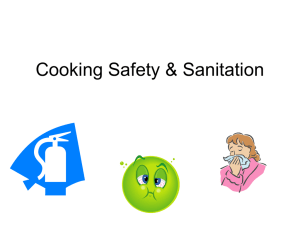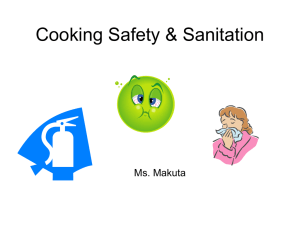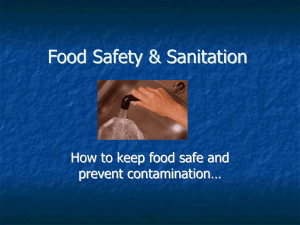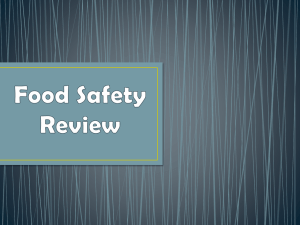Cooking Safety & Sanitation
advertisement
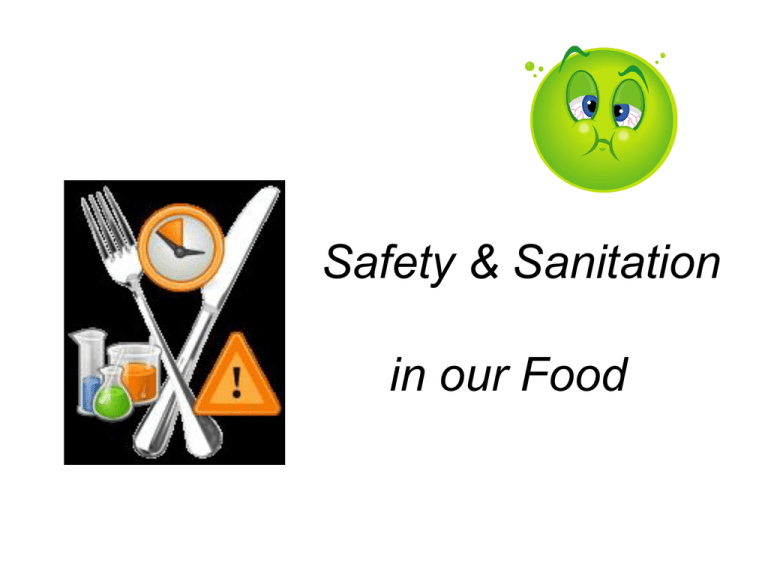
Safety & Sanitation in our Food Why Safety First? • Over 5,000 deaths • 76 million illnesses • 325,000 hospitalizations from foodborne illness each year! Who is at risk? a) Infants & Young Children B) Pregnant Women C) The Elderly D) Chronically-ill People Why are these people at risk? Their immune systems may not be able to fight off the bacteria and viruses that cause foodborne illnesses. At Risk: a) Infants & Young Children Infants and children are more vulnerable because their immature stomachs produce less acid. Less acid makes it easier for bacteria and viruses to multiply. At Risk: b) Pregnant Women Pregnant women are at risk because a fetus does not have a fully developed immune system. At Risk: c) The Elderly The elderly are more susceptible to foodborne illness because of: • inadequate nutrition • lack of protein in their diets • poor blood circulation. At Risk: d) Chronically-ill People People who are chronically-ill or who take medication that affects their immune system are also at greater risk of becoming sick from a foodborne illness. Chronically-ill people have long-term illnesses. This could include: cancer diabetes AIDS patients people who take antibiotics Foodborne Illness: A disease carried or transmitted to people by food that contains harmful substances. Food-based Hazards • Biological • Chemical • Physical People-based Hazards • Food handling • Time & Temp abuse • Cross contamination • Poor hygiene • Improper cleaning & sanitizing Biological hazards: come mainly from microorganisms such as: Bacteria - single-celled organisms that thrive in room-temperature foods. Virus - the smallest and simplest life-form known. Fungi - group of microorganisms that includes molds and yeasts. Parasite – a microorganism that needs a host to survive. Microorganisms that cause diseases are called pathogens. Not all microorganisms are bad. Can you think of a good bacteria? A good type of mold? Where would bread be without yeast? Some bacteria are not infectious by themselves, BUT as the bacteria multiply they discharge toxins. These toxins are naturally-occurring poisons. One example is Botulism, which is caused by the toxin produced from the bacterium Clostridium botulinum. Chemical hazards: Chemical hazards include substances such as: *cleaning solutions *sanitizers *insect sprays Physical hazards: • Physical hazards are foreign particles found in food such as: *glass *metal *band-aids *chewing gum *bobby pins *paper clips *hair How can I handle food safely? Bacteria like Staphylococci are found on the hair, skin, mouth, nose and throat of healthy people. According to one estimate, nearly 50% of healthy food handlers carry disease agents that can be transmitted by food. A cough or sneeze can transmit thousands of microorganisms that may cause disease. Cover your mouth when you cough or sneeze. Wash your hands after coughing, sneezing, fixing your hair, blowing your nose, or using the rest room. Wear a hair net or pull long hair back. Cover cuts on your hands and arms with a bandage. Wear plastic gloves and clean aprons or clothes while preparing food. CLEAN - SEPARATE COOK - CHILL http://www.foodsafety.gov/ Cross Contamination Definition: The transferring of bacteria from person or object to another. Lather Up • Always wash hands, cutting boards, dishes, and utensils with hot, soapy water after they come in contact with raw meat, poultry, and seafood. Safely Separate • Separate raw meat, poultry, and Take Two seafood from other foods in your If possible, use one cutting board for grocery shopping cart and in your fresh produce and use a separate one for refrigerator. raw meat, poultry, and seafood. Seal It • To prevent juices from raw meat, poultry, or seafood from dripping onto Clean Plate other foods in the refrigerator, place Never place cooked food back on the these raw foods in sealed containers same plate or cutting board that or plastic bags. previously held raw food. Marinating Mandate • Sauce that is used to marinate raw meat, poultry, or seafood should not be used on cooked foods, unless it is boiled before applying. http://www.foodsafety.gov/~fsg/f00separ.html Cross Contamination Raw or contaminated foods that touch or drip fluids on cooked and ready-to-eat foods. Danger Zone Temperature… … 400 to 1400 F. … promotes the growth of bacteria. … where bacteria multiply rapidly. Cook foods to a safe temperature! • The U.S. Public Health Service classifies moist, high-protein, and/or low acid foods as potentially hazardous. High protein foods consist, in whole or in part, of milk or milk products, shell eggs, meats, poultry, fish, shellfish, edible crustacea (shrimp, lobster, crab). Potentially Hazardous Foods PHF: Support rapid growth of microorganisms. • Every 20 minutes bacteria double. • Foods have naturally occurring bacteria living on them that are there to break down the food. • How can you remember this? By the acronym FAT TOM. FAT TOM F: Food – Animal origin foods that are raw or heat treated – Plant origin foods that are heat treated A: Acidity – 4.6-7.5 ideal for bacteria growth – High acidity neutralizes the bacteria – Acid will eat the protein T: Temperature – 40˚F or colder – 140˚F or hotter T: Time – Food can be in the danger zone for a maximum of 2 hours before becoming hazardous O: Oxygen – Allows bacteria to grow – Wrap food products tightly to eliminate exposure to oxygen M: Moisture – Bacteria need moisture to grow When in Doubt, Throw it Out! • Throw away fresh fruits and vegetables that have not been refrigerated within two hours of cutting, peeling, or cooking. • Remove and throw away bruised or damaged portions of fruits and vegetables when preparing to cook them or before eating them raw. • Throw away any fruit or vegetable that will not be cooked if it has touched raw meat, poultry or seafood. The difference between Clean & Sanitize CLEAN • No visible dirt or gunk. SANITIZE • Removal of all harmful microorganisms. • Wash surface with soap & water. • Use 180˚F water. • Use sanitizer liquid such as bleach. Dish Washing Use a Dish Cloth - not a Sponge! • Sponges contain approximately 7.2 billion Germs! • That is the equivalent to smearing an 8 oz. raw piece of chicken on your surface! • We use dish cloths because we wash them after every use. Quiz: What is the correct way to disinfect a sponge? A. B. C. D. Wash it in the sink Throw it in the dishwasher Throw it in the microwave Let it dry out • Put wet sponge into the microwave, and set it for at least one minute. According a study by the USDA, microwaving for one minute significantly lowers bacteria counts and populations of mold and yeast more than other methods.[3] Researchers have also discovered that after microwaving for two minutes, more than 99% of all the living bacteria will be dead.[4] • Allow sponge to cool. Dishwasher Method • Place it into the utensil compartment of the next wash and dry cycle. Allow it to remain for the entire wash and dry cycle. • Remove it after the washer stops. The sponge will now have 99.9998% less bacteria on it. [5] How to Wash Dishes 1. SET up sinks and drying rack as seen below Sink 1 Hot Soapy H20 WASH Sink 2 Drying Rack HOT H20! RINSE *Note: The hotter the water the faster the dishes will dry because hot water evaporates quicker DRY Foodborne Microorganisms 1. 2. 3. 4. 5. 6. 7. 8. 9. Salmonella: found on poultry & eggs Listerosis: found on deli/ ready to eat meats Botulism: found in improperly canned canned goods, baked potatoes, honey. Hepatitis A: Found in human feces & can contaminate any food a human touches Staphylococcus : Found on humans in high concentrations under fingernails and in nostrils Trichinosis: Parasite found primarily in pork caused by animals eating other animals Yeast: Fungus known to appear pink and/or bubble especially in bad sour cream & jelly Ecoli: Primarily in beef Shigellosis: Potato salad, tuna, shrimp, macaroni How to Wash Dishes 2. Scrape Dishes to clear food 3. Lightly rinse dishes and stack by category 4. Wash dishes by category 5. Rinse dishes 6. Put in drying rack 7. Allow dishes to air dry 8. Put away dishes 9. Let water go down & empty food particles from sink 10. Clean sink and put washing & drying towels in washer
